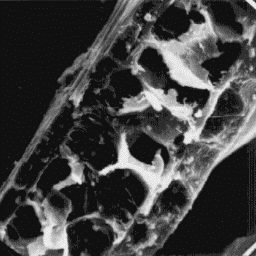 Ornithorhynchus anatinus
Ornithorhynchus anatinus
------------------------
English: Platypus
German: Schnabeltier
French: Ornithorhynque
Spanish: Ornithorhynqua
Distribution areas
------------------
The platypus lives in East Australia, in
Tasmania and other islands south of the
continent.
Description of the fur
----------------------
The skins are from 40 to 50 cm long; the Transverse section
tail is about 15 cm long. The upper part of of a guard hair, 1000x
the body is dark-brown in colour, and the
belly part is from yellow-brown to white in colour. The undercoat is dense
and soft, the coarse hairs are straight and up to 17 mm long. The upper layer
has a lustrous appearance. The tail is covered by coarse hairs coloured in
dark-brown shades.
|
|
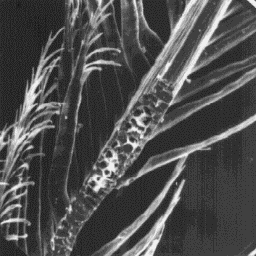 Ornithorhynchus anatinus
Ornithorhynchus anatinus
------------------------
English: Platypus
German: Schnabeltier
French: Ornithorhynque
Spanish: Ornithorhynqua
Structure of the hair
---------------------
The microscopic skin surface is usually
furrowed; the hair follicles are narrow
with straight edges and contain cluster of
hairs.
The fine fur fibres are from 15 to 25 µm
in diameter. The cross-section is Transverse section
elliptical and the cuticular scales are of a guard hair, 200x
comb-like with a smooth surface and
straight scale margins. These fine fibres are
non-medullated.
|
|
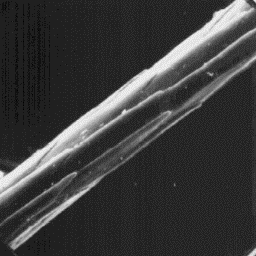 Ornithorhynchus anatinus
Ornithorhynchus anatinus
------------------------
English: Platypus
German: Schnabeltier
French: Ornithorhynque
Spanish: Ornithorhynqua
The intermediate fibres are elliptical
or flat-shaped in cross-section with a
diameter of 30 to 70 µm. The cuticular
scales are of the rounded tile-like type or
of the crenated tile-like type. In the
upper parts these fibres also have
indistinctly-shaped scales. The inter-
mediate fibres are not medullated.
The cuticular structure
The guard hairs are straight and have a of the fine fibres, 1000x
flat-shaped cross-section with the larger
diameter up to 400 µm. In this animal some of the guard hairs have the
distinctively shaped cross-section of the branched type. These branched
shafts are covered by branched-like scales with a smooth surface and straight
scale margins. Other guard hairs are covered by rounded tile-like scales, in
the upper parts also by indistinctly shaped scales. The scale surface and
margins are smooth. Only the branched guard hairs are medullated. Here the
medulla is wide, unbroken and central symmetrical-shaped. The medulla is of
the lattice type with a sheet-like infilling substance.
|
|
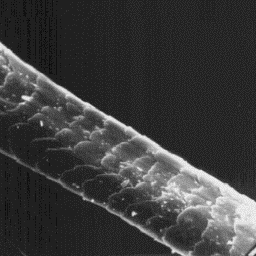 Ornithorhynchus anatinus
Ornithorhynchus anatinus
------------------------
English: Platypus
German: Schnabeltier
French: Ornithorhynque
Spanish: Ornithorhynqua
The cuticular structure
of an intermediate hair, 1000x
|
|
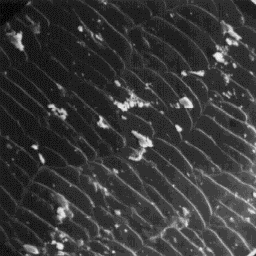 Ornithorhynchus anatinus
Ornithorhynchus anatinus
------------------------
English: Platypus
German: Schnabeltier
French: Ornithorhynque
Spanish: Ornithorhynqua
The cuticular structure
of a guard hair, 1000x
Numerical code for platypus skin structure
------------------------------------------
Surface of the skin: 3-4-3
Fine fur fibres: 2-6-1-1-4-0-0-0-0-15.25-5.11
Intermediate fibres: 2.3-3.4-1-1-4-0-0-0-0-30.71-8.15
Guard hairs: 3.9-3.15-1-1-4.2-.1-.1-.8-.1-70.401-10.8
|




